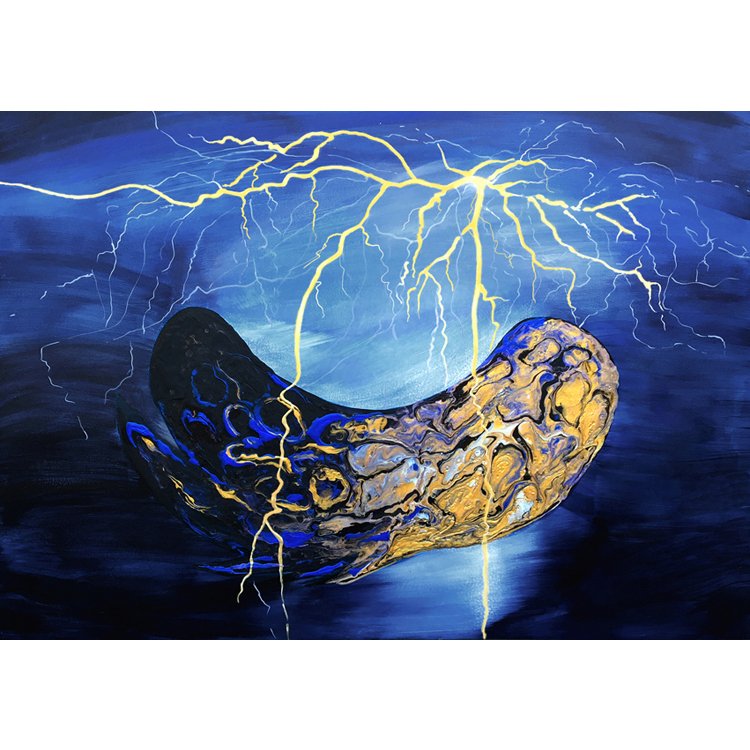Cradle 18” x 24” Acrylic on Wood Panel
A conversation by Ishkhan Jinbashian with artist Seta Injeyan
“Organic Flows,” Seta Injeyan’s newest series of paintings, is a wide-eyed exploration of the very mechanics of the human body. Pulsating with bold, opulent colors and intricate compositions that at turns weave together or juxtapose the titular flows, these paintings reflect, at first sight, Injeyan’s fascination with the workings — and interrelationships — of internal organs. And while this could well serve as a purpose unto itself, as an impetus for a strictly esthetic study of biology, Injeyan pursues a far broader goal, seeking to discover layers and dimensions of meaning beyond the esthetic and scientific alike.
The Armenian Arts Gallery will feature the first public exhibition of Injeyan’s “Organic Flows” series with an opening artist reception on November 16. The exhibition will also be open on November 17
Born in Aleppo, Syria, Seta Injeyan moved with her family to Los Angeles at a young age. She is a graduate of the renowned Art Center College of Design in Pasadena. Her paintings have been exhibited throughout the United States, Europe, and Japan, garnering critical acclaim. She is also the recipient of numerous awards. We spoke with Injeyan at her Studio in Los Angeles.
Q – In your series of paintings titled “Road to the Sky,” “Dynamo Road,” and “In the Nanopresent,” you depict the idea of forward motion, with roads and freeways, as well as car mirrors, functioning as props, or parallel conduits, to journeys into the realm of the psychological and the spiritual. Do you consider your latest series, “Organic Flows,” as an organic outgrowth of the road paintings?
A – Definitely. I think there is a natural evolution between the road paintings and my newest series, whereby freeways and roads, as the geographical arteries of modern life, have transmuted into the workings of our internal organs, including and specially the heart, lungs, and brain. So, in terms of composition, I started out with the macrocosm of concrete-and-steel routes and arrived at a microcosm of inner routes.
Q – In both cases, however, the search for realities and understandings beyond the empirical remains a constant, doesn’t it?
A – Yes. Just like the various road series concern a dialogue between the physical road and the inner road, my latest paintings symbolize the biological concomitants of life’s endeavors, at the root level.
Q – There is a sense of awe that’s prevalent in all of these paintings, in which various organs of the human body are manifested as the vital, dynamic components of an overarching story. Is this what inspired you to depict them?
A – I think these organs are breathtakingly beautiful, in terms of both design and function. We tend to take them for granted, until something goes wrong. Meanwhile they do their job quietly, in the background. I find that there’s something magical, something supple, in their biological rigor and highly-sophisticated efficiency.
Q – What are some of the metaphorical attributes, in relation to specific organs, that you’re particularly fond of?
A – I see the heart as playing a central role, of course. As the body’s main engine, this is an organ replete with poetic and spiritual significance, one that’s as important as its purely bodily function.
Also bear in mind that, despite the advances of medical science, despite our unprecedented understanding of the way the heart and other organs work, there’s still something mysterious about them. Consider the liver, for instance, which I’ve depicted in the painting entitled “Prometheus.” Not only does the liver cleanse and detoxify, it is the only organ that actually renews itself. This is about the persistent renewal of life itself, and it commands our respect. Meanwhile, the brain is in constant electrical contact with all the organs, empowering new chemistry, growth, and renewal.
Q – One of your most striking paintings devoted to the heart is one depicting the organ in the shape of a jug. It’s a work dedicated to Daniel Varoujan, and features two translated lines from his poetry: “My heart is the empty vessel / And I go to the source of the light.” Can you talk about your affinity for Varoujan’s work?
A – Given his genuinely universal stance, his bold and innovative language, and astoundingly rich imagery, Varoujan is, to me, as much a literary hero as a spiritual pillar. I painted the work you refer to and dedicated it to Varoujan because I’m particularly fond of the idea of the heart being an empty vessel, a tabula rasa, that’s open to the world and new ideas, without prejudice or preconception.
Q – In another of your recent paintings, a pair of lungs are portrayed in the shape of a tree, with the resulting image whispering of oneness of human and natural.
A – This painting is an expression of my abiding reverence for the concept of harmony — equally as it relates to health awareness and environmental stewardship. By painting a pair of lungs in the shape of a tree, I’ve sought to celebrate their equally fundamental roles as life-giving forces.
Q – Is there a takeaway from your “Organic Flows” series that you find particularly noteworthy?
A – I think painting is a constant learning process, enabling one to discover ever-newer things about oneself and, by extension, the world in which we live. I’ve found working on the “Organic Flows” series to be deeply exhilarating, as it has given me the opportunity to imagine and construct flows of resplendent beauty, and to find liberation in their freedom of movement.
The Armenian Observer, Nov. 7th, 2018, Page 3
